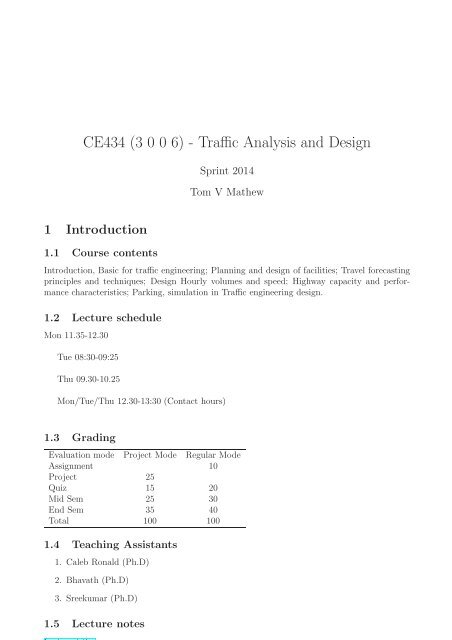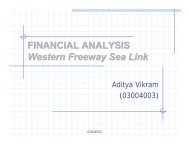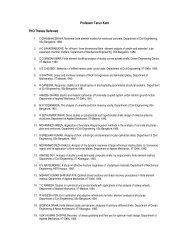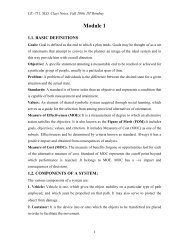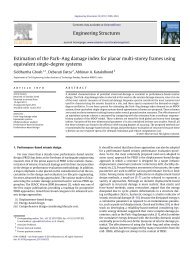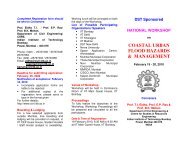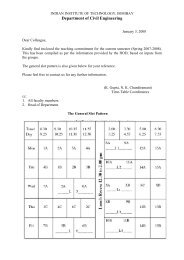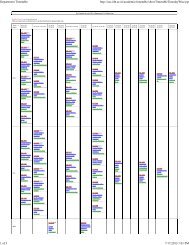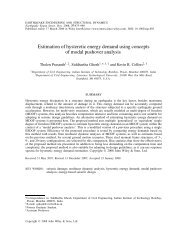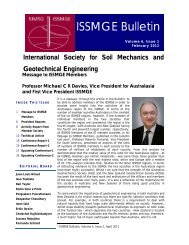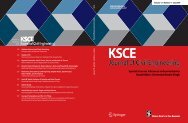Printer friendly page - Department of Civil Engineering, IIT Bombay
Printer friendly page - Department of Civil Engineering, IIT Bombay
Printer friendly page - Department of Civil Engineering, IIT Bombay
Create successful ePaper yourself
Turn your PDF publications into a flip-book with our unique Google optimized e-Paper software.
CE434 (3 0 0 6) - Traffic Analysis and Design<br />
Sprint 2014<br />
Tom V Mathew<br />
1 Introduction<br />
1.1 Course contents<br />
Introduction, Basic for traffic engineering; Planning and design <strong>of</strong> facilities; Travel forecasting<br />
principles and techniques; Design Hourly volumes and speed; Highway capacity and performance<br />
characteristics; Parking, simulation in Traffic engineering design.<br />
1.2 Lecture schedule<br />
Mon 11.35-12.30<br />
Tue 08:30-09:25<br />
Thu 09.30-10.25<br />
Mon/Tue/Thu 12.30-13:30 (Contact hours)<br />
1.3 Grading<br />
Evaluation mode Project Mode Regular Mode<br />
Assignment 10<br />
Project 25<br />
Quiz 15 20<br />
Mid Sem 25 30<br />
End Sem 35 40<br />
Total 100 100<br />
1.4 Teaching Assistants<br />
1. Caleb Ronald (Ph.D)<br />
2. Bhavath (Ph.D)<br />
3. Sreekumar (Ph.D)<br />
1.5 Lecture notes
2 Evaluation<br />
2.1 Assignments<br />
To be announced later.<br />
2.2 Course Project<br />
The course project is based on Traffic <strong>Engineering</strong> s<strong>of</strong>tware VISSIM.<br />
1. Decide a traffic situation to study by your own. Collect relevant field data. Assume rest<br />
<strong>of</strong> the data, preferably from books/reports/journal papers. Write the problem statement<br />
in your words. Simulate and evaluate the facility, and report the results.<br />
2. Some sample problem statements are below. They are presented in the order <strong>of</strong> complexity.<br />
You may select the one <strong>of</strong> the following problem, and modify. Or write a problem<br />
statement <strong>of</strong> your own.<br />
3. Identification <strong>of</strong> a similar study report from published sources (journals, conference, etc.,)<br />
before the commencement <strong>of</strong> the work will be helpful.<br />
4. All field data collected should be preserved, preferably using video.<br />
2.2.1 Some sample problems<br />
1. Modeling traffic stream characteristics: Typical steps include: Flow and speed<br />
data collection from uniform road stretch; Data extraction and analysis; Calibration<br />
and validation <strong>of</strong> some popular stream model; and Simulation <strong>of</strong> facility in VISSIM and<br />
comparison with field data.<br />
2. Analysis <strong>of</strong> unsignalized intersections: Typical steps include: Data collection such<br />
as volume, composition, gap acceptance, speed, etc.; Analysis will include determining<br />
critical gap and capacity; Suggest possible measures to improve intersection performance;<br />
and Demonstration using simulation.<br />
3. Analysis signalized intersections Data collection such as geometry, current signal<br />
timing plans, volume, saturation flow, and delays. Represent the same in VISSIM after<br />
calibration. Suggest improvement <strong>of</strong> the signal and demonstrate in VISSIM.<br />
4. Development <strong>of</strong> PCU values Develop PCU values <strong>of</strong> a traffic facility (three lane road,<br />
signalized intersection, rotary, etc.) by various methods and study the sensitivity <strong>of</strong> the<br />
vehicle composition using VISSIM.<br />
5. Traffic management studies in VISSIM: Typical field problem<br />
(a) Coordinated traffic signals between <strong>IIT</strong> Market gate, Main gate and Pizza-hut junction.<br />
(b) Traffic signal operations at <strong>IIT</strong> Main gate junction (including pedestrian).<br />
(c) Existing and proposed traffic operation inside <strong>IIT</strong> Campus (comprising main gate,<br />
market gate, KV school, and academic area).<br />
(d) Traffic management and vehicle routing problem to eliminate congetion (for example
(e) Parking management system study. How the parking operation around a facility can<br />
be optimally designed.<br />
6. Develope an adaptive or vehicle actuated traffic control algorithm and evaluate using<br />
VISSIM. The project involves good understanding <strong>of</strong> C/C++ or java programming and<br />
s<strong>of</strong>tware inclination (PHD:AP).<br />
7. Modeling mixed traffic with discrete choice theory: The project deals with the lateral<br />
movements <strong>of</strong> the vehicles observed more significantly in Indian traffic conditions. Tasks<br />
involved: (i) Choice theory formulation using angle based approach (ii) 1 hr Data collection<br />
and extraction for estimation <strong>of</strong> the proposed modeling approach (iii) Validation<br />
with 15 min traffic data. Ref: Yasuhiro. S., Teruaki. H., Nobuhiro. U., Hiroshi. S.,<br />
2014. Modelling mixed traffic flow with motorcycles based on discrete choice approach.<br />
Proceedings <strong>of</strong> the 93rd Annual Meeting <strong>of</strong> Transportation Research Board, Washington<br />
DC. (PHD: CRM)<br />
8. Calibration <strong>of</strong> Lane changing model in VISSIM: The project deals with the calibration and<br />
validation <strong>of</strong> lane changing model present in the traffic simulation tool VISSIM with the<br />
real world data. Tasks involved: (i) Identification <strong>of</strong> the lane changing model parameters<br />
in VISSIM (ii) Calibration <strong>of</strong> the parameters using 1hr real world data (iii) Validation <strong>of</strong><br />
the model with the number <strong>of</strong> lane changes observed and lane change duration. Ref: Tony<br />
Woody, 2006. Calibrating freeway simulation models in VISSIM. MS thesis, University<br />
<strong>of</strong> Washington. (PHD: CRM)<br />
9. Development <strong>of</strong> headway models for motorcycles in mixed traffic: The project deals with<br />
development <strong>of</strong> multidimensional headway models appropriate for motorcycle movement<br />
in mixed traffic conditions. Tasks involved: (i) Data collection on a typical urban road.<br />
(ii)Observation <strong>of</strong> the data collected and identifying the unique travel patterns <strong>of</strong> twowheelers<br />
(iii) Data extraction for the parameters required to explain the identified patterns<br />
(iv) Model estimation using appropriate estimation tools( eg., Bayesian estimation using<br />
some available tools) Ref: Lee. T., Polak., J W., Bell. M G., 2009. New approach to<br />
modelling mixed traffic containing motorcycles in urban areas. Journal <strong>of</strong> Transportation<br />
Research Board, 2140: 195-205. (PHD: CRM)<br />
10. Development <strong>of</strong> a car-following model using particle interaction analogy: The project<br />
deals with the development <strong>of</strong> a new car-following model similar to GM model using<br />
the dynamics involved in particle interaction system. Tasks involved: (i) Basic theory<br />
<strong>of</strong> particle interaction system (ii) Development <strong>of</strong> analogy with traffic system (iii) A<br />
numerical example illustrating the correctness <strong>of</strong> the analogy developed (iv)Testing <strong>of</strong><br />
the model with 15min car-following data collected. Note: The particle interaction is just<br />
one <strong>of</strong> the examples. You can think <strong>of</strong> any other dynamical system applied in other fields.<br />
Motivation <strong>of</strong> this project: Successful engineers take old ideas from one field and apply<br />
it to other fields. (PHD: CRM)<br />
11. Simulate the traffic (both homogeneous and heterogeneous) on a two-lane road <strong>of</strong> 5 km<br />
with a side-road at 3km point. Flow on the side-road can be varied so that the vehicles<br />
after the 3km point face congestion. Evaluate the exit flow, density and travel time<br />
for the whole section. The simulator should be calibrated using appropriate field data<br />
(PHD:SM).<br />
12. Simulate the following problem using VISSIM. Consider a long homogeneous freeway <strong>of</strong>
5 km long occurs from 10 to 15 km measured from the upstream entrance <strong>of</strong> the freeway.<br />
In order to release the traffic jam condition downstream, the authority blocks the freeway<br />
entrance for 10 min, after which traffic is released again from the freeway entrance at the<br />
capacity density <strong>of</strong> 75 veh/km. After 20 min, the entrance flow returns back to normal<br />
with a density <strong>of</strong> 50 veh/h. Study how traffic density changes at various location <strong>of</strong> the<br />
freeway 10, 30, 60 and 90 minutes. (Bas paper: Transportation Research Part B 42 (2008)<br />
355-372) (PHD:SM)<br />
13. Simulate the following problem using VISSIM. On Wednesday 9:00 AM, there is an accident<br />
on northbound Interstate- 91. The traffic operation center (TOC) has to decide how<br />
to clean up the accident. After collecting information and communicate with highway<br />
patrol and emergency operator, the TOC determines that there are two alternatives: Alternative<br />
1: Completely shut the Interstate <strong>of</strong>f for 10 minutes, cleanup, and then reopen<br />
the Interstate for normal operation, or Alternative 2: Partially open the Interstate at<br />
reduced capacity, but the cleanup requires longer time - about 30 minutes - before normal<br />
operation can be resumed. One <strong>of</strong> the concerns at the TOC is how long the queue will<br />
spill back because the queue on the Interstate will overflow via ramps and further block<br />
upstream surface streets. As a transportation engineering student, you are asked to <strong>of</strong>fer<br />
you knowledge to help the TOC make decision. (Base paper: Lecture notes in traffic flow<br />
theory by Daiheng Ni, 2012) (PHD:SM)<br />
References<br />
[1] D R Drew. Traffic flow theory and control. McGraw-Hill Book Company, New York, 1968.<br />
<strong>IIT</strong>B–.<br />
[2] Highway Capacity Manual. Transportation Research Board. National Research Council,<br />
Washington, D.C., 2000.<br />
[3] L. R Kadiyali. Traffic <strong>Engineering</strong> and Transportation Planning. Khanna Publishers, New<br />
Delhi, 1987.<br />
[4] S K Khanna and C E G Justo. Highway <strong>Engineering</strong>. Nemchand Bros.,, Roorkee, 1991.<br />
[5] M L Manheim. Fundamentals <strong>of</strong> transportation systems analysis Vol.1. MIT Press, 1978.<br />
[6] Adolf D. May. Fundamentals <strong>of</strong> Traffic Flow. Prentice - Hall, Inc. Englewood Cliff New<br />
Jersey 07632, second edition, 1990.<br />
[7] William R McShane, Roger P Roesss, and Elena S Prassas. Traffic <strong>Engineering</strong>. Prentice-<br />
Hall, Inc, Upper Saddle River, New Jesery, 1998.<br />
[8] C. S Papacostas. Fundamentals <strong>of</strong> Transportation <strong>Engineering</strong>. Prentice-Hall, New Delhi,<br />
1987.<br />
[9] M Whol and B V Martin. Traffic system analysis for engineers and planners. McGraw Hill,<br />
Inc., 1983.


